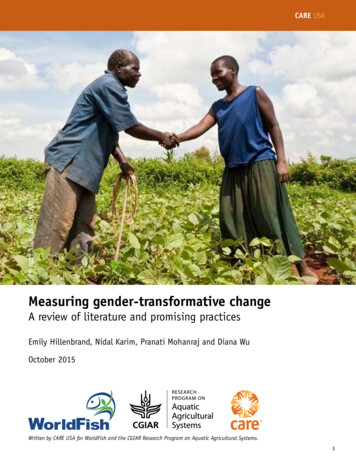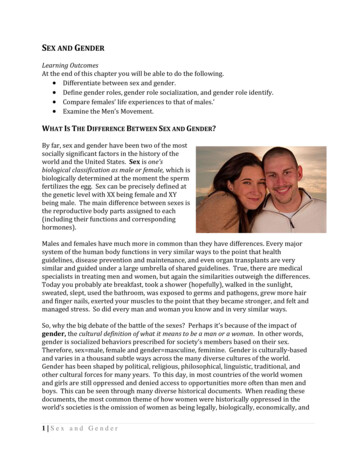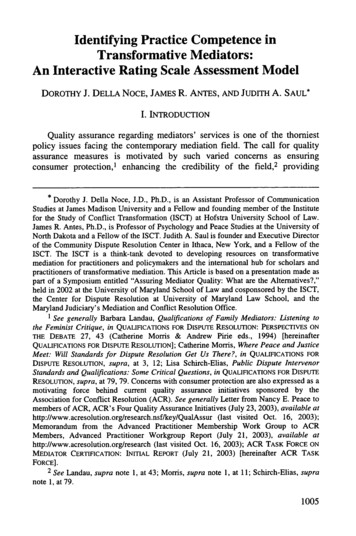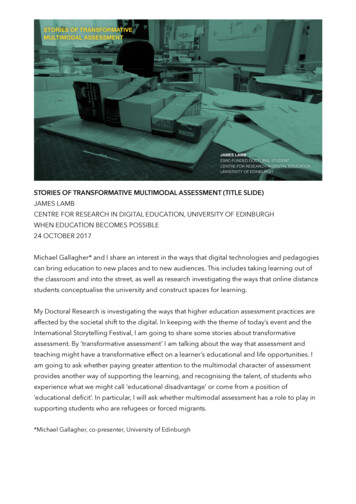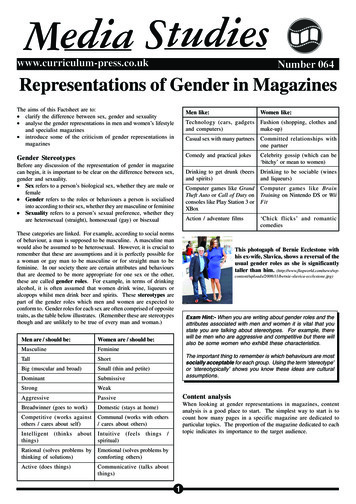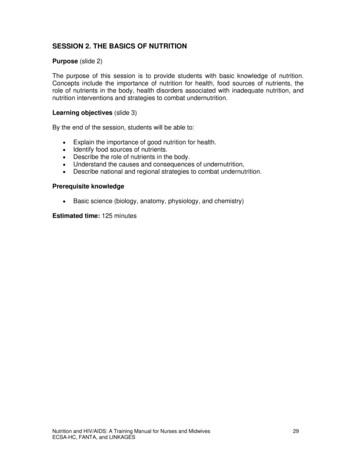
Transcription
GENDER TRANSFORMATIVENUTRITION PROGRAMMING (LESSONSFROM GROW PROJECT)February 28, 2020Module 1
OVERVIEWTo fulfil the rights to food security and nutrition for women and youth,small-scale producers and their families, the project:1. Used an integrative approach to food and nutrition security,2. Promoted access to critical inputs like water, land, seeds, finance,and access to Markets3. Included socio-cultural and environmental solutions4. Put women’s empowerment at the heart of its interventions2
OVERVIEW CONT Works directly with women of reproductive age and lactating women tostrengthen their skills and confidence in: Sustainable improved agriculture practicesFinancial inclusionMarket engagementGender equalityFood and nutrition security Engaging with men and boys to support efforts to greaterequality3
APPROACHES TO EFFECT GENDER TRANSFORMATIVECHANGE IN NUTRITON PROGRAMMINGDefining and understanding the desired change Transformative: Projects “actively” seek to build equitable socialnorms and structures in addition to individual gender-equitablebehaviorWhen Does This Happen?1. When women engage in community structures to increase their activeparticipation and decision-making (especially in male-dominatedsettings)2. When women act as role models and leaders in non-traditional roles(extension agents, aggregators, supervisors, marketers and trainers)4
APPROACHES CONT 3. When there is real change in household economic decision-makingand control over income or assets4. When private sector policies or practices are influenced to servethe interests/needs of women. This includes encouraging privatesector actors to change product/service offerings to meet the needs offemale consumers (as expressed by consumer demand surveys).5
APPROACHES CONT Social Analysis and Action (SAA): An effective tool forGender Transformation SAA is an approach CARE has developed to catalyze aprocess of exploration and reflection, and facilitateindividual and community actions that support moreequitable gender/social norms and positive/healthybehaviors.6
The core elements driving SAA are:7
SAA facilitates critical reflection and dialogue (CRD) on how social andgender norms, as well as power relations, shape our perceptions andexpectations of ourselves and others, and influence our decisions andbehaviors.8April 13, 2020
Core elements of SAA:Through these steps, SAA facilitates critical reflection and dialogue (CRD) on how social norms andnder norms, as well as power relations, shape our perceptions and expectations of ours Through these steps, SAA facilitates critical Reflect to create understanding of how norms related to gender and sexualityinfluence health, women’s economic empowerment, food security, nutrition, and GBV Challenge norms by taking concrete steps to address health, food and nutritionsecurity, economic empowerment and other social issues through a reflective actioncycle, supporting changes in individual attitudes and social norms, leading to greatergender equality in households, communities, and society Explore by envisioning alternatives based on a realization of the negative effectsnorms have on wellbeing and development outcomes, and moving towards alternativeways of thinking and behaving Learn how gender, social, and power norms shape perceptions/expectations of othersand ourselves and influence decisions and behaviorsments driving SAA are: Reflect to create understanding of how norms related to gender and sexuality influence health, women’s economic empowerment, food security, nutrition, and GBV.9 Challenge norms by taking concrete steps to address health, food and nutrition security, economic empowerment and other social issues through a reflection action cycle, supporting changes in individual attitudes and social norms,leading to greater gender equality in households, communities, and society. Explore by envisioning alternatives based on a realization of the negative effects norms have on wellbeing and development outcomes, and moving towards alternative ways of thinking and behaving Learn how gender, social, and power norms shape perceptions/ expectations of others and ourselves and influence decisions and behaviours elves and others, and influence our decisions and behaviors.
SAAReflection with community involves:Community Groups: women and men that influence and perpetuate socialnorms, but who are in a better position to reflect, change and takecollective action against norms and practices that are barriersCore Groups: primarily government and service providers who are part ofthe reflection and change process, provide supportive supervision tocommunity groups and execute community mobilizations10
SAASAA Tools: 11Exploratory in natureCreativity and ability to respond to a community’s specific contextFacilitation versus challengingProvide safe space for exploring values and practicesCollect data and stimulate discussionAllow deeper exploration and provide different techniques
SAASAA Major outcomes include: CARE staff, collaborating partner communities with greaterawareness of gender and power norms and greater facility indiscussing them More equitable social and gender norms at the individual,household and community levels resulting in sector-specific andcross-cutting behavior change at the household, community andinstitutional level More effective existing programs resulting in concrete12improvements in the lives of women and their communities
Gender Empowerment Framework:These models are informed by theCARE Gender Equality Frameworkthat defines women’s empowermentand gender equality through thethree complementary changedomains:1. Increased agency2. Improved relations3. Transformed structures13April 13, 2020
MEN AND BOYS ENGAGEMENTCARE’s work with men and boys ontransforming gender norms hasmade great strides in exploring andexpanding ideas around what itmeans “to be a man” and definitionsof masculinity within theircommunities.14April 13, 2020
CRITICAL STEPS IN GENDER TRANSFORMATIVENUTRITION PROGRAMMING1)Project Gender integrationProject Gender integration assessment:assessment:CARE’s Gender Marker is a self-assessment tool that measures theintegration of gender into programming measured along the CARE GenderContinuum; from harmful to transformative.The Gender Marker: Enables CARE to track, improve and support more effective, genderequitable programming using grades from 0 to 4 Is used in conjunction with Monitoring, Evaluation and Accountabilitysystems, which measure outcomes for all members of the target population.15
Practical Lessons from GROW The GROW project undertook the assessment at the start of theproject and found out the design on the project interventions andimplementation strategies are gender responsive. To evaluate progress, the assessment was done in the 4th fiscalyear of the project; the results showed that the projecttransitioned from gender responsive programming to a gendertransformative one.16
CRITICAL STEPS IN GENDER TRANSFORMATIVENUTRITION PROGRAMMING2) Gender integration assessment –Gender and power analysis for SAA: A systematic attempt to identify key issues contributing to gender,social and power inequalities, many of which also contribute to poordevelopment outcomes. Aims to collect, identify, examine, and analyze information on thedifferent power-holders, norms, networks, and roles of men andwomen.17April 13, 2020
PRACTICAL LESSONS FROM GROWIn line with the baseline study, a stand-alone gender and power analysiswas conducted to inform the gender strategy and projectimplementations.Some of the norms identified were: Lack of equitable and sustainable access to nutritious foods The persistence of stereotypical gender division of food labor Intra-household food allocation Imbalanced power dynamics Inequality in decision making18
STORIES OF CHANGEShek Kadir is one of the religiousleaders of Abadir kebele. In hiscommunity, there was a belief thatonly dominated and powerlesshusbands would help their wifewith domestic chores or let themspeak in public. Since influentialpeople from 5 different villagesstarted to attend Social Analysisand Action meetings, perspectivestartedtochangeandKadirwitnessed a decrease of femalestudents’ absenteeism and dropout in his community.
CRITICAL STEPS IN GENDER TRANSFORMATIVENUTRITION PROGRAMMING3. Staff transformationBeliefs, attitudes, and values of staff are shaped by thesocieties they live in – just like the people in thecommunities where development programs operate. SAA begins by transforming the capacity of programstaff members This continues throughout the process cycle. It usually begins with the staffs’ own capacitytransformation, which is a continuous process. This process usually begins with a training-of-trainersfor SAA with program staff.20April 13, 2020
PRACTICAL LESSONS FROM GROWAll staff received SAA training: Gender focal persons selected in each operational site toadvocate for gender equality though they were not genderexperts On-going staff reflection was held quarterly throughout theproject implementation period among the staff21April 13, 2020
CRITICAL STEPS IN GENDER TRANSFORMATIVENUTRITION PROGRAMMING4) Integrating SAA into existing platforms:SAA is not a stand-alone intervention and should be integrated intoprograms with sector-specific goals and impact-level indicators.SAA should be viewed as a means to an end, a process thatproduces intermediate-level outcomes that contribute to higher-levelgoals.This means that the most appropriate indicators for monitoring andevaluating SAA are outcome-level.22
PRACTICAL LESSONS FROM GROW The project worked through the existing structures such asmother-to-mother groups and father-to-father groups to sustain thedesired outcome and prevent disruption. Trainings on AMIYCN, VSLA, NSA were rendered to the groups andSAA was an integral and core approach employed to empowerwomen and bring the desired change in household nutrition. A SAA discussion manual was developed following the genderbarriers identified during the formative research. Subsequently, the groups conducted gender dialogues using theSAA discussion guide.23
Stories of change“My husband was verytraditional in managing his house and didn’twant me to be involved in any of the assets wehad.Hisparticipationinthewomenempowerment for improved nutrition dialoguehas impacted him. He now thinks of discussinghouse or family issues with me and believesour house can be best-managed by deciding onthem together.”Sada Mohamad Amad, 27 years old, MesalaWoreda, Abadir Kebele, mother of 5
CRITICAL STEPS IN GENDER TRANSFORMATIVENUTRITION PROGRAMMING:5) Gender-Responsive Monitoring, Evaluation and Learning: The changes that SAA aims to facilitate are ambitious andambiguous, typically take a long time, and are rarely linear. A responsive MEL system is therefore needed which recognizeschange as a process instead of an endpoint. This means MEL systems used to measure changes through SAAmust document and learn from incremental changes towards thelarger goals.25
PRACTICAL LESSONS FROM GROW:GROW used a rolling profile tool to assess gradual changes in thecommunity’s perception and attitude towards gender equality in nutritionprogramming. Changes in Empirical Expectations Normative Expectations Sanctions; Sensitivity to sanctions Exceptions were assessed26
SOME ACHIEVEMENTS ON GENDER EQUALITYGender in WASH: Increasing women’s representation in WASHcommittees, reduced GBV due to improved access to water pointsGender in Agriculture: challenging stereotyped household roles byengaging men in management of homestead gardens and enhancingwomen’s access to nutritious crops; emerging of women in agriculturaltechnology fieldsEconomic empowerment: creating solidarity among women VSLAgroups and facilitating better access to credit
SOME ACHIEVMENT CONT Gender in Nutrition: balanced intra-household food allocation;breaking food taboos on pregnant women and children; challengingmisconceptions on EBF and EI Self-efficacy: improved women’s autonomy, decision making powerand leadership capacity Women’s aspiration: women’s engagement in new businessstreams and male dominated professions28April 13, 2020
Thank you!29
CRITICAL STEPS IN GENDER TRANSFORMATIVE NUTRITION PROGRAMMING Project Gender integration 1) Project Gender integration assessment:assessment: CARE’s Gender Marker is a self-assessment tool that measures the integration of gender into programming measured along the CARE Gender Continuum; from

